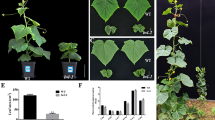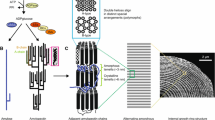Abstract
The heterotetrameric enzyme hydroxynitrile lyase (HNL) from sorghum (EC 4.1.2.11) is involved in the catabolism of the cyanogenic glycoside dhurrin. We have isolated a cDNA clone comprising about 90% of the COOH terminal sequence of a precursor which encodes both subunit of HNL from Sorghum bicolor L. (SbHNL). Hence the subunits of SbHNL must be the result of post-translational processing. The deduced amino acid sequence of HNL shares significant sequence homology with members of the serine carboxypeptidase family. In particular, HNL from sorghum shares the catalytical triad Asp, His, and Ser with these enzymes which evolved in 3 groups of enzymes (carboxypeptidase, chymotrypsin, and subtilisin) by convergent evolution. Moreover, like serine carboxypeptidases, HNL from sorghum consists of two pairs of glycosylated cysteine linked A and B chains forming a heterotetramer of a molecular weight of 105000 (carboxypeptidases 120000). Thus, HNL from sorghum closely resembles to serine carboxypeptidases but differs from all other HNLs described so far. Western blotting experiments revealed cross reaction between carboxypeptidase from wheat and anti SbHNL antisera. Therefore, convergent evolution of HNLs from various ancestoral enzymes is conceivable. Hybridization of SbHNL cDNA to northern blots of total RNAs isolated from various organs of young sorghum seedlings shows the same expression pattern of HNL as found by means of western blotting or enzyme assays. Using PCR and Southern blot analysis, we demonstrated that the gene of SbHNL is free of introns. Further sequence analysis of cDNA clones and genomic DNA revealed a stretch of 23 adenine residues in the 3′-untranslated part of the gene. Both, intronless organisation of the gene and a genomic stretch of oligo A suggests that SbHNL may have evolved by a reverse transcription event.
Similar content being viewed by others
Abbreviations
- CPDB:
-
barley serine carboxypeptidase
- CPDW:
-
wheat serine carboxypeptidase
- CPDY:
-
yeast serine carboxypeptidase
- DFP:
-
diisopropylfluorophosphate
- HNL:
-
hydroxynitrile lyase
- mAb:
-
monoclonal antibody
- PCR:
-
polymerase chain reaction
- SbHNL:
-
hydroxynitrile lyase from Sorghum bicolor L.
- SDS-PAGE:
-
sodium dodecyl sulfate polyacrylamide gel electrophoresis
References
Albrecht J, Jansen I, Kula M-R: Improved purification of an (R)-oxynitrilase from Linum ussitatissimum (flax) and investigation of the substrate range. Biotechnol Appl Biochem 17: 191–203 (1993).
Baulcombe DC, Barker RF, Jarvis MG: A gibberellin-responsive wheat gene has homology to yeast carboxypeptidase Y. J Biol Chem 262: 13726–13735 (1987).
Becker W, Benthin U, Eschenhof E, Pfeil E: Zur Kenntnis der Cyanhydrinsynthese II. Biochem Z 337: 156–166 (1963).
Blin N, Stafford DW: Isolation of high-molecular-weight DNA. Nucl Acids Res 3: 2303 (1976).
Bové C, Conn EE: Metabolism of aromatic compounds in higher plants. Purification and properties of the oxynitrilase of Sorghum vulgare. J Biol Chem 236: 207–210 (1961).
Breddam K, Sorensen SB, Svendsen I: Primary structure and enzymatic properties of carboxypeptidase II from wheat bran. Carlsberg Res Commun 52: 297–311 (1987).
Carvalho FJP: Studies on the aliphatic ketone cyanohydrin hydroxynitrile lyases from Manihot esculenta Crantz Ph. D. dissertation, University of California, Davis (1981).
Cheng I-P, Poulton JE: Cloning of Prunus serotina (R)-(+)-mandelonitrile lyase and identification of a putative FAD-binding site. Plant Cell Physiol 34: 1139–1143 (1993).
Cho WL, Deitsch KW, Raikhel AS: An extraovarian protein accumulated in mosquito oocytes is a carboxypeptidase activated in embryos. Proc Natl Acad Sci USA 88: 10821–10824 (1991).
Conn EE: Cyanogenic glycosides. In: Conn EE (ed) Secondary Plant Products, Vol. 7. The Biochemistry of Plants, pp. 479–500. Academic Press, New York (1981).
Effenberger F, Hörsch B, Förster S, Ziegler T: Enzymecatalyzed synthesis of (S)-cyanohydrins and subsequent hydrolysis to (S)-α-hydroxy-carboxylic acids. Tetrahedron Lett 31: 1249–1250 (1990).
Effenberger F, Ziegler T, Förster S:Enzymkatalysierte Cyanhydrin-Synthese in organischen Lösungsmitteln. Angew Chem 99: 491–492 (1987).
Galjart NJ, Gillemans N, Meijer D, D'Azzo A: Mouse ‘protective protein’. J Biol Chem 265: 4678–4684 (1990).
Galjart NJ, Morreau H, Willemsen R, Gillemans N, Bonten EJ, D'Azzo A: Human lysosomal protective protein has cathepsin A-like activity distinct from its protective function. J Bio Chem 266: 14754–14762 (1991).
Gerstner E, Pfeil E: Zur Kenntnis des Flavinenzyms Hydroxynitril-Lyase (D-Oxynitrilase). Hoppe Seyler's Z Physiol Chem 353: 271–286 (1972).
Gerstner E, Kiel U: Eine neue Mandelsäurenitril-Lyase (D-Oxynitrilase) aus Prunus laurocerasus (Kirschlorberr). Hoppe Seyler's Z Physiol Chem 356: 1853–1857 (1975).
Gerstner E, Mätzke V, Pfeil E: Zur chemischen und biologischen Systematik der Rosaceen. Naturwissenschaften 55: 561–563 (1968).
Hayashi R, Bai Y, Hato T: Evidence for an essential histidine in carboxypeptidase Y. J Biol Chem 250: 5221–5226 (1975).
Hösel W, Nahrstedt A: Spezifische Glucosidasen für das Cyanglucosid Triglochinin. Reinigung und Charakterisierung von β-Glucosidasen aus Alocasia macrorrhiza Schott. Hoppe Seyler's Z Physiol Chem 356: 1265–1275 (1975).
Hu WN, Kopachik W, Band RN: Cloning and characterization of transcripts showing virulence-related gene expression in Naegleria fowleri. Infect Immun 60: 2418–2424 (1992).
Jansen J, Woker J, Kula M-R: Purification and protein characterization of hydroxynitrile lyases from sorghum and almond. Biotechnol Appl Biochem 15: 90–99 (1992).
Kojima M, Poulton JE, Thayer SS, Conn EE: Tissue distribution of dhurrin and of enzymes involved in its metabolism in leaves of Sorghum bicolor. Plant Physiol 63: 1022–1028 (1979).
Kuroki GW, Conn EE: Mandelonitrile lyase from Ximenia americana L.: stereospecificity and lack of flavin prosthetic group. Proc Natl Acad Sci USA 86: 6978–6981 (1989).
Laemmli UK: Cleavage of structural proteins during the assembly of the head of bacteriophage T4. Nature 227: 680–685 (1970).
Liao D-L, Remington SJ: Structure of wheat serine carboxypeptidase II at 3.5-Å resolution. J Biol Chem 265: 6528–6531 (1990).
Liao D-L, Breddam K, Sweet RM, Bullock T, Remington J: Refined atomic model of wheat serine carboxypeptidase II at 2.2-Å resolution. Biochemistry 31: 9796–9812 (1992).
Lieberei R, Selmar D, Biehl B: Metabolization of cyanogenic glucosides in Hevea brasiliensis. Plant Syst Evol 150: 49–63 (1985).
Logeman J, Schell J, Willimitzer L: Improved method for the isolation of RNA from plant tissues. Anal Biochem 163: 16–20 (1987).
Sanger F, Nickle S, Coulson AR: DNA sequencing with chain terminating inhibitors. Proc Natl Acad Sci USA 74: 5463–5467 (1977).
Seigler DS: Cyanide and cyanogenic glycosides. In: Rosenthal GA, Berenbaum MR (eds) Herbivores, 2nd ed., pp. 35–77. Academic Press, New York (1992).
Selmar D, Lieberei R, Biehl B: Mobilization and utilization of cyanogenic glycosides. Plant Physiol 86: 711–716 (1988).
Sorensen SB, Breddam K, Svendsen I: Primary structure of carboxypeptidase I from malted barley. Carlsberg Res Common 51: 475–485 (1986).
Sorensen SB, Svendsen I, Breddam K: Primary structure of carboxypeptidase II from malted barley. Carlsberg Res Commun 52: 285–295 (1987).
Sorensen SB, Svendsen I, Breddam K: Primary structure of carboxypeptidase III from malted barely. Carlsberg Res Common 54: 193–202 (1989).
Towbin H, Staehlin T, Gordon J: Electrophoretic transfer of proteins from acrylamide gels to nitrocellulose. Proc Natl Acad Sci USA 76: 4350–4354 (1979).
Valls LA, Hunter CP, Rothman JH, Stevens TH. Protein sorting in yeast: the localization determinant of yeast vacuolar carboxypeptidase Y residues in the propeptide. Cell 48: 887–897 (1987).
Wajant H, Mundry K-W: Hydroxynitrile lyase from Sorghum bicolor. a glycoprotein heterotetramer. Plant Sci 89: 127–133 (1993).
Wajant H, Böttinger H, Mundry K-W: Purification of hydroxynitrile lyase from Sorghum bicolor L. (sorghum) by affinity chromatography using monoclonal antibodies. Biotechnol Appl Biochem 18: 75–82 (1993).
Washio K, Ishikawa K: Structure and expression during the germination of rice seeds of the gene for a carboxypeptidase. Plant Mol Biol 19: 631–640 (1992).
Wu HC, Poulton JE: Immunocytochemical localization of mandelonitrile lyase in mature black cherry (Prunus serotina Ehr.) seeds. Plant Physiol 96: 1329–1337 (1991).
Xu LL, Singh BK, Conn EE: Purification and characterization of mandelonitrile lyase from Prunus lyonii. Arch Biochem Biophys 250: 322–328 (1986).
Xu LL, Singh BK, Conn EE: Purification and characterization of acetone cyanohydrin lyase from Linum usitatissimum. Arch Biochem Biophys 263: 256–263 (1988).
Yemm RS, Poulton JE: Isolation and characterization of multiple forms of mandel onitrile Lyase from mature black cherry (Prunus serotina Ehr.) seeds. Arch Biochem Biophys 247: 440–445 (1986).
Young RA, Davis RW: Efficient isolation of genes by using antibody probes. Proc Natl Acad Sci USA 80: 1194–1198 (1983).
Author information
Authors and Affiliations
Rights and permissions
About this article
Cite this article
Wajant, H., Mundry, KW. & Pfizenmaier, K. Molecular cloning of hydroxynitrile lyase from Sorghum bicolor (L.). Homologies to serine carboxypeptidases. Plant Mol Biol 26, 735–746 (1994). https://doi.org/10.1007/BF00013758
Received:
Accepted:
Issue Date:
DOI: https://doi.org/10.1007/BF00013758




